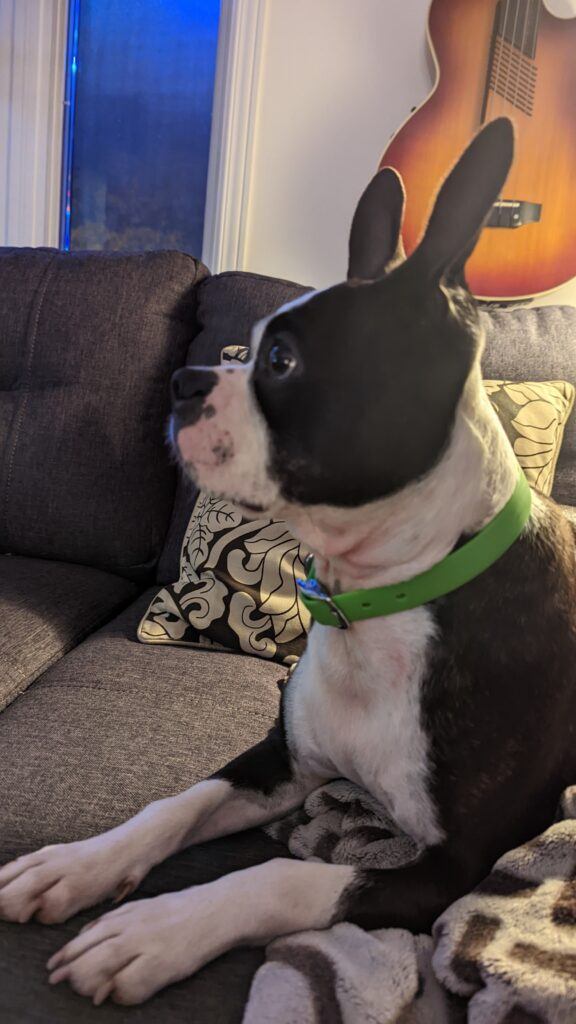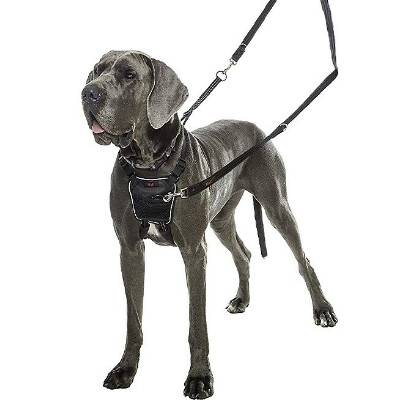Dog collars come in all shapes, colors and sizes. While there are many different types of dog collars on the market, some are more popular than others. In this post, we will take a look at five different types of dog collars: the standard leash collar, the choke chain, the prong collar, the harness and the no-pull collar. Each type of collar has its own benefits and drawbacks, so it is important to know which type of collar is best for your dog. Stay safe and happy with your pup by using the right type of collar!
The Standard Leash Collar
The standard leash collar is the most common type of collar used on dogs. It is a simple collar that attaches to a leash, and is typically made from nylon or leather. Lately, silicone ones have entered the market as well. This type of collar is comfortable for most dogs to wear, and is suitable for use during walks, runs, and other activities. We personaly just use it as an dog tag holder.
The Choke Chain
The choke chain is a type of collar that tightens around the dog’s neck when pulled. This type of collar is typically used for training purposes, as it can help to correct behavioral problems such as pulling on the leash. However, some experts believe that choke chains can be harmful to dogs, as they can cause neck injuries.
The Prong Collar
The prong collar is similar to the choke chain, but instead of tightening around the dog’s neck, it pinches the skin. This type of collar is also typically used for training purposes, but like the choke chain, it can be harmful to dogs if not used properly.

The Harness
The harness is a type of collar that goes around the dog’s chest and shoulders, rather than their neck. This type of collar is often used for dogs who pull on the leash, as it can help to distribute the force evenly and prevent neck injuries. Additionally, harnesses are often used for dogs who are elderly or have respiratory problems, as they can help to prevent choking. In the case of a Boston Terrier, it is best advised to use a harness because of their bulging eyes and their tendencies to have complications. When walking, pulling on the leash (they pull alot if you don’t train them well) creates a lot of pressure and can give them cherry eyes.
Find out more on Cherry Eyes here——–>Why Are My Boston Terrier’s Eyes Red?
The No Pull Collar
The no pull collar is a type of harness that includes a strap that attaches to the dog’s leash and goes around their chest. This strap helps to prevent the dog from pulling on the leash by applying pressure when they try to move forward. No pull collars are ideal for dogs who are strong pullers or have a tendency to escape from their collars.
You can have a good description if you click and follow the link on the previous picture 🙂
Find The Right Collar For Your Dog on Amazon!
Conclusion
There you have it. 5 different types of dog collars. I have not tried all of them. Honestly, through time and with all the dogs I had the pleasure to share my life with for a few years, I came to appreciate the harness for the walks. That’s what I use because it’s the most comfortable for my little buddy Ivar. I have used chokers in the past with my husky X labrador and it didn’t do her any good. I personaly don’t think it should even exist. Prong collars should not either. I’m against inflicting pain for training. I know trainers who never use them and they still get results.
The no-pull harness seemed a good option if your dog pulls a lot but with no experience on that product, I can not discuss this one much. If you have, I would love to have your comments on it.
One more thing I would like to add is that lately we have been using the silicone collar when we don’t put Ivar on a leash. We only use it for ID puposes like I said. I really like it so far because he doesn’t seem notice it much, it doesn’t chaffe him and, it may seem trite but nothing sticks to it. No food or liquids stick to it and it doesn’t get dirty or at least is easy to clean. Leather and fabric collars have a tendency to get muddy and stink. You probably know me a little by now so guess what, a stinky collar will not make it in the house 😉
Thanks a lot for taking some of your precious time to read my blog and please come back often. Comments are welcome !
J-F
As an Amazon Associate I earn from qualifying purchases but prices are the same if you buy using one of my links as if you searched by yourself. I’m only saving you time. Find out more in our Affiliate Link Disclosure.




Brian Hudon
Great job. I love the set up, It’s amazing . Great choice of colors. “Dog collars come in all shapes, colors and sizes. While there are many different types of dog collars on the market, some are more popular than others. In this post, we will take a look at five different types of dog collars: the standard leash collar, the choke chain, the prong collar, the harness and the no-pull collar.” This so true. It makes me want to buy immediately .
admin
Hi Brian! thanks for your comment, I really appreciate the compliments. I’m not exactly certain of which type you would buy immediately though, can you enlighten me?
LineCowley
Different body sizes and shapes in dogs mean that they require different collars. We have always found leather to be the best material for the collars for our dogs, as anything synthetic might cause a rash. And because synthetic materials do not breathe, they are too hot for the tro[pical climate that we live in.
Our dogs wear a standard collar, mainly so that we can attach their identification discs to it, but when we take them out for a walk, we always use a harness. I am trying to work out what the difference is between a no pull collar and a harness? I know you say you do not have experience with it, but it would be very helpful to have more detail, or an image, to show what a no pull collar is. Thank you.
admin
Hi Line! You bring some very good insight on the subject! May I ask what breed of dogs you have?
I live in a colder area (Canada) so the hot climate was never an issue lol. In our case synthetic was better but I can see why it’s not for everyone. As for the no pull harnes, I did put a picture as you mentionned and if you click on it it will bring you to a buying site but with very good information as well. I hope you get the information you need there 🙂
Thank you and come back often!
Alberto
Great work with the article. I’ve had a dog for 6 years now, her name is Samoa. We’ve always thought that the standard and the choke chain are a bit too uncomfortable for dogs, so we chose to use a harness. We think it provides more support and safety for our dog since the weight is spread more evenly.
Thanks for sharing!
admin
Thanks for your input Alberto! The chokes collars should not exist anymore but all we can do is stop buying them. What breed of dog is Samoa?